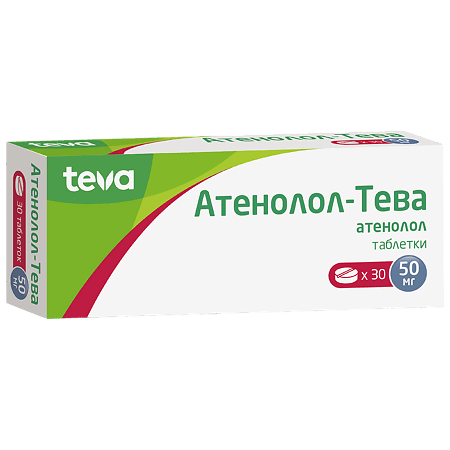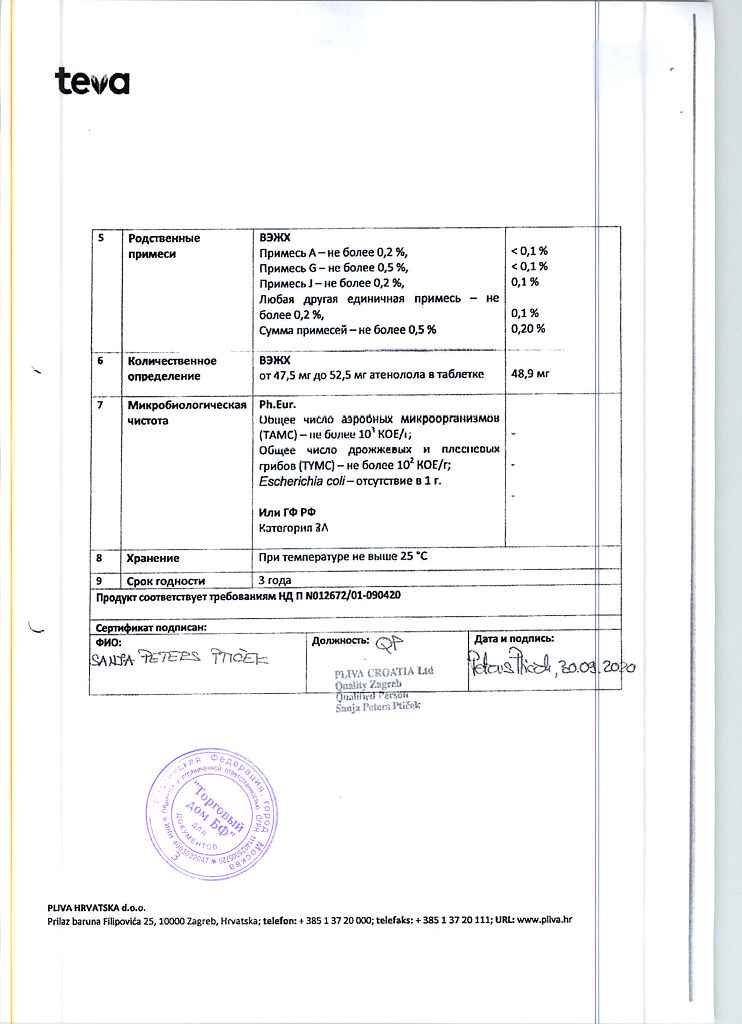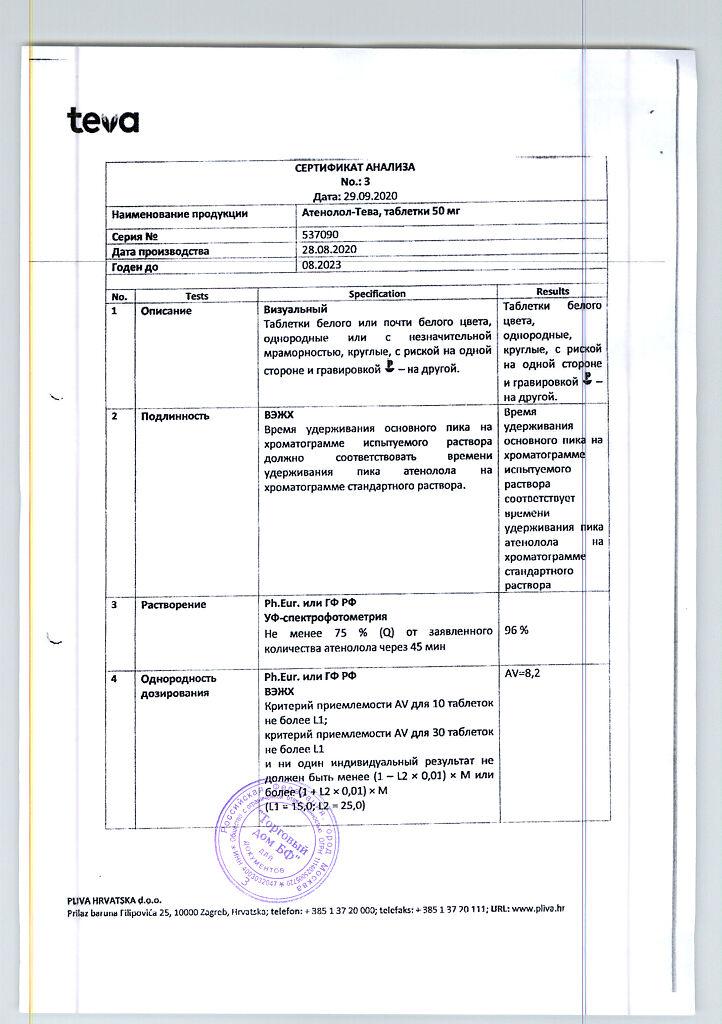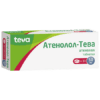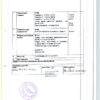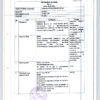No products in the cart.
Atenolol, 50 mg 30 pcs.
€1.00
Out of stock
(E-mail when Stock is available)
Description
Pharmacodynamics
Athenololol has antianginal, hypotensive and antiarrhythmic effects. It has no membrane stabilizing and intrinsic sympathomimetic activity. It reduces the stimulation by catecholamines of the formation of cAMP and ATP, reduces the intracellular Ca 2 + flow. In the first 24 hours after oral administration against the background of a decrease in cardiac output there is a reactive increase of total peripheral vascular resistance, which intensity gradually decreases during 1-3 days.
The hypotensive effect is associated with decreased cardiac output, decreased activity of the renin-angiotensin system, barocereceptor sensitivity and influence on the central nervous system. The hypotensive effect is manifested by a decrease in systolic and diastolic blood pressure, a decrease in stroke and minute volumes. In medium therapeutic doses, it has no effect on peripheral arterial tone. The hypotensive effect lasts for 24 hours and stabilizes by the end of 2 weeks of treatment if taken regularly. The antianginal effect is determined by reduction of myocardial oxygen demand as a result of reduction of heart rate (prolongation of diastole and improvement of myocardial perfusion) and contractility, as well as by reduction of myocardial sensitivity to sympathetic innervation.
It reduces heart rate at rest and during exercise. By increasing ventricular muscle fiber tension and end diastolic pressure, in the left ventricle may increase myocardial oxygen demand, especially in patients with chronic heart failure.
The antiarrhythmic action is manifested by suppression of sinus tachycardia and is associated with the elimination of arrhythmogenic sympathetic effects on the cardiac conduction system, inhibition of heterogeneous automaticity, reduction of the speed of excitation propagation through the sinoauricular node .and prolongation of the refractory period. Inhibits conduction of impulses in antegrade and, to a lesser extent, in retrograde direction through the atrioventricular node and along accessory pathways. It increases survival of patients who have had myocardial infarction (reduces the frequency of ventricular arrhythmias and angina attacks).
It slightly decreases the vital capacity of the lungs, practically does not weaken the bronchodilator effect of isoproterenol. In therapeutic concentrations it has no effect on beta-2-adrenoreceptors, in contrast to non-selective beta-adrenoblockers it has less significant effect on the smooth muscle of the bronchi and peripheral arteries and on lipid metabolism. When taken more than 100 mg per day it may have beta-2-adrenoblocking effect.
The negative chronotropic effect appears 1 hour after ingestion, peaks 2-4 hours later and lasts up to 24 hours.
Pharmacokinetics
The drug is rapidly absorbed from the gastrointestinal tract after oral administration, approximately 50% of the oral dose. Fat solubility is poor, bioavailability is 40-50%, time to reach maximum blood plasma concentration after oral administration – 2-4 hours. It penetrates poorly through the blood-brain barrier, passes in small amounts through the placental barrier and into breast milk. Binding with blood plasma proteins is 6-16%. It is practically not metabolized in the liver. The elimination half-life is 6-9 hours (it increases in elderly patients).
Extracted by kidneys through glomerular filtration (85-100% unchanged). Impaired renal function is accompanied by prolongation of the elimination half-life and cumulation: in creatinine clearance below 35 mg/min/1.73 m2, the elimination half-life is 16-27 hours, in clearance below 15 mg/min – more than 27 hours (it is necessary to reduce doses). It is excreted during hemodialysis.
Indications
Indications
Active ingredient
Active ingredient
Composition
Composition
1 tablet contains:
active ingredient: atenolol 50 mg,
excipients: microcrystalline cellulose, sodium microscarmellose, sodium lauryl sulfate, polyethylene glycol 6000, silicon dioxide, talc, magnesium stearate
How to take, the dosage
How to take, the dosage
The drug is taken orally before meals, without chewing, with a small amount of liquid.
Hypertension.
The treatment is started with 50 mg atenolol once daily. It takes 1-2 weeks of therapy to achieve a stable hypotensive effect. If hypotensive effect is not sufficiently pronounced, the dose is increased to 100 mg per dose. Further increase of the dose is not recommended, as it is not accompanied with increase of clinical effect.
Intensive angina pectoris.
The initial dose is 50 mg per day. If optimal therapeutic effect is not achieved within a week, the dose is increased to 100 mg per day. Sometimes it is possible to increase the dose to 200 mg, once a day. In elderly patients and patients with impaired renal function the dose should be adjusted according to creatinine clearance. In patients with renal insufficiency with creatinine clearance values higher than 35 ml/min/1.73 m (normal value is 100-150 ml/min/1.73 m2) there is no significant cumulation of atenolol. The following maximum doses are recommended for patients with renal insufficiency:
Creatinine clearance
(mL/min/1.73)
Serum creatinine concentration
(cmol/L)
Atenolol dose
15-35
300-600
50 mg daily
>600
50 mg every other day or
100 mg once every 4 days
Patients on hemodialysis receive atenololol 50 mg daily immediately after each in-patient dialysis under close medical supervision, as there is a risk of arterial hypotension. In elderly patients, the initial single dose is 25 mg (can be increased under control of BP, HR).
Enlargement of the daily dose above 100 mg is not recommended because the therapeutic effect is not increased and the possibility of side effects increases. The maximum daily dose is 200 mg. Decrease the dose if cancellation is planned, in 1/4 dose every 3 to 4 days.
Interaction
Interaction
Concomitant use of ATENOLOLOL and insulin (or other oral antidiabetic agents) may increase their hypoglycemic effect.
The concomitant use of atenolol with antihypertensive agents of other groups leads to increased hypotensive effect. When taking atenolol with verapamil (or diltiazem) there is a mutual enhancement of the cardiodepressant effect.
The hypotensive effect is weakened by estrogens (sodium retention)
The risk of bradycardia and atrioventricular conduction disturbances increases when co-administered with cardiac glycosides.
Concomitant administration with reserpine, methyldopa, clonidine, verapamil may cause marked bradycardia.
Patients taking atenololol and clonidine concomitantly should not be discontinued until several days after stopping treatment with atenolol.
Concomitant intravenous administration of verapamil and diltiazem can provoke cardiac arrest; nifedipine can lead to a significant decrease in BP
The simultaneous use of atenololol with ergotamine derivatives, xanthine, nonsteroidal anti-inflammatory drugs reduces the effectiveness of atenolol.
Simultaneous use with lidocaine may decrease its excretion and increase the risk of lidocaine toxicity.
The concomitant use of atenolol with phenothiazine derivatives contributes to increased serum concentrations of each drug.
Phenytoin when administered intravenously, means for general anesthesia increases the severity of cardiodepressive effects.
Therapeutic effect may be mutually suppressed when concomitantly taken with eufylline and theophylline.
The concomitant use with MAO inhibitors is not recommended.
Allergens used for immunotherapy or allergen extracts for skin tests increase the risk of severe systemic allergic reactions or anaphylaxis.
Inhalation anesthetics (hydrocarbon derivatives) increase the risk of myocardial dysfunction and arterial hypotension.
Amiodarone increases the risk of bradycardia and inhibits AV conduction.
Cimitidine increases plasma concentrations (inhibits metabolism).
Iodine-containing radiopaque agents for intravenous administration increase the risk of anaphylactic reactions.
Prolongs the effects of nonpolarizing myorelaxants, anticoagulation effect of coumarins.
The tri- and tetracyclic antidepressants, antipsychotics, sedatives, sleeping pills and ethanol increase CNS depression. Precautions
Monitoring of patients taking atenolol should include monitoring of HR and BP (daily at the beginning of treatment, then once every 3-4 months), blood glucose content in diabetic patients (once every 4-5 months). In elderly patients it is recommended to monitor kidney function (once every 4-5 months).
The patient should be taught the method of heart rate calculation and instructed to consult a physician if the heart rate is less than 50/min.
In thyrotoxicosis, atenolol may mask certain clinical signs of hyperthyroidism (e.g., tachycardia). Abrupt withdrawal in patients with thyrotoxicosis is contraindicated because it can exacerbate the symptoms. Unlike non-selective beta-adrenoblockers, it practically does not increase insulin-induced hypoglycemia and does not delay recovery of blood glucose concentration to normal levels.
In patients with coronary heart disease (CHD), abrupt withdrawal of beta-adrenal blockers may increase the frequency or severity of angina attacks, so stopping atenolol in CHD patients should be done gradually.
Dose selection in patients with decompensated cardiac function also requires special attention. Compared with non-selective beta-adrenoblockers, cardioselective beta-adrenoblockers have less effect on lung function, nevertheless in obstructive airway diseases Atenolol should be prescribed only in case of absolute indications. The use of beta 2-adrenomimetics may be recommended in some cases if they need to be prescribed.
Patients with bronchospastic disorders may be prescribed cardioselective adrenoblockers in cases of intolerance and/or ineffectiveness of other hypotensive drugs, but the dosage should be closely monitored. Overdose is dangerous with the development of bronchospasm.
Particular attention is necessary in cases where surgical intervention under anesthesia is required in patients taking Atenolol. The drug administration should be discontinued 48 hours before the surgical intervention. As an anesthetic, a drug with the lowest possible negative inotropic effect should be chosen.
If Atenolol and clonidine are used concomitantly, Atenolol should be discontinued several days before clonidine in order to avoid the withdrawal symptoms of the latter.
The severity of hypersensitivity reactions may increase, and the lack of effect of usual doses of epinephrine against a background of a history of allergy is possible.
Drugs that reduce catecholamine stores (e.g., reserpine) can potentiate the effects of beta-adrenoblockers, so patients taking these combinations of drugs should be under constant medical monitoring for arterial hypotension or bradycardia.
In elderly patients with significant bradycardia (less than 50 bpm), arterial hypotension (systolic BP less than 100 mmHg), AV blockade, bronchospasm, ventricular arrhythmias, severe liver or renal impairment, the dose should be reduced or treatment should be stopped.
It is recommended that therapy be discontinued if depression develops as a result of taking beta-adrenoblockers.
If intravenous verapamil administration is necessary, this should be done at least 48 hours after taking Atenolol.
The use of Atenolol may decrease tear fluid production, which is important for patients who wear contact lenses.
Atenolol should not be stopped abruptly because of the risk of severe arrhythmias and myocardial infarction. Withdrawal is done gradually, reducing the dose over 2 weeks or more (reduce the dose by 25% every 3 to 4 days).
The drug should be discontinued before testing blood and urine levels of catecholamines, normetanephrine and vanillylmindalic acid; antinuclear antibody titers.
The effectiveness of beta-adrenoblockers is lower in smokers.
Special Instructions
Special Instructions
At the time of treatment it is necessary to refrain from driving and engaging in potentially dangerous activities that require high concentration and quick psychomotor reactions.
Contraindications
Contraindications
Side effects
Side effects
The majority of side effects associated with atenolol use are mild and transient.
The most common side effects are mainly related to the pharmacological effects of the drug and are expressed as follows:
cardiovascular system: the appearance of symptoms of heart failure, atrioventricular conduction disorder, bradycardia, marked decrease in blood pressure, palpitations.
with the central nervous system: Dizziness, sleep disturbance, decreased ability to concentrate, drowsiness, depression, hallucinations, lethargy, fatigue, headache, weakness, headache, insomnia, nightmares, anxiety, confusion or short-term memory loss, impaired reactivity, parasthesias in extremities (in patients with “intermittent” claudication and Raynaud syndrome), muscle weakness, seizures;
Gastrointestinal side: dry mouth, nausea, vomiting, diarrhea, abdominal pain, constipation ;
respiratory system: dyspnea, apnea, bronchospasm,; hematological reactions: thrombocytopenic purpura, anemia (aplastic); thrombosis;
endocrine system: gynecomastia, decreased potency, decreased libido; hyperglycemia (in patients with insulin-independent diabetes), hypoglycemia (in patients receiving insulin), hypothyroidism; metabolic reactions: hyperlipidemia;
dermal reactions: urticaria, dermatitis, itching, photosensitivity, increased sweating, skin hyperemia, exacerbation of the course of psoriasis;
Sensory organs: visual disturbance, decreased tear fluid secretion, dry and sore eyes, conjunctivitis, vasculitis, chest pain;
fetal effects: intrauterine growth retardation, hypoglycemia, bradycardia;
laboratory parameters: agranulocytosis, leukopenia, changes in the activity of “liver” enzymes, bilirubin levels;
other: “withdrawal” syndrome (increased angina pectoris attacks, increased BP), reversible alopecia, back pain, arthralgia.
The frequency of side effects increases with increasing the dose of the drug.
Overdose
Overdose
Symptoms: bradycardia, atrioventricular block of II and III degree, marked decrease in blood pressure, increasing symptoms of heart failure, bronchospasm, hypoglycemia, dizziness, fainting, arrhythmia, ventricular extrasystoles, cyanosis of finger nails or palms, seizures.
Treatment: gastric lavage and administration of adsorptive agents. If bronchospasm occurs, inhalation or intravenous administration of the beta 2-adrenomimetic salbutamol is indicated. In AV conduction disorders, bradycardia – intravenous injection of 1-2 mg of atropine, epinephrine or placement of a temporary pacemaker. In ventricular extrasystole – lidocaine (do not use class IA drugs), in arterial hypotension – the patient should be in Trendelenburg position. If there are no signs of pulmonary edema – intravenous plasma exchange solutions, if ineffective – injection of epinephrine, dopamine, dobutamine. In heart failure – cardiac glycosides, diuretics, glucagon, in convulsions – intravenous diazepam. Dialysis may be performed.
Pregnancy use
Pregnancy use
Pregnant women should prescribe Atenolol only when the benefit to the mother exceeds the potential risk to the fetus. Atenolol is excreted with breast milk, so it should be taken with great caution only in exceptional cases during lactation.
Similarities
Similarities
Additional information
| Shelf life | 5 years |
|---|---|
| Conditions of storage | At 15-25 °C |
| Manufacturer | Pliva Hrvatska d.o.o., Croatia |
| Medication form | pills |
| Brand | Pliva Hrvatska d.o.o. |
Related products
Buy Atenolol, 50 mg 30 pcs. with delivery to USA, UK, Europe and over 120 other countries.

